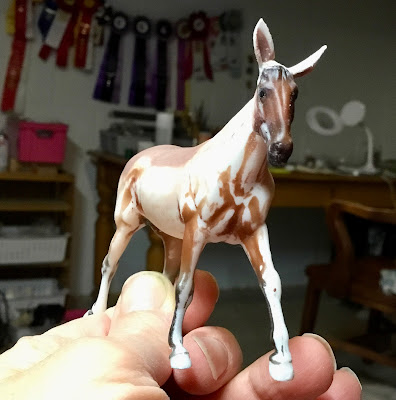My challenge participation record is far from stellar. In fact, my ICEE model from 2020 is *almost* done.
Here's Lacie, a mule on the Indian Pony mold. She still needs a touch more prepping.
 |
| Lacie, my ICEE project from 2020, wasn't finished in time. |
 |
| This mold didn't work as well for this project as I had hoped. |
So what day is today? Sign up day for ICEE 2021! And what am I doing? Trying again. With another mule project on another new mold.
Artist statement: I am planning to make "Porter" a walking Stablemate-scale mule suitable for English performance from the Irish Draft/Corbin model. He is be inspired by a real mule of the same name (http://showhorsegallery.com/gallery/porter)
 | ||||
| My 2021 ICEE Breyer Stablemate |
If you are new to customizing, I hope you'll join in. This event is held to motivate artists of all skill levels to challenge themselves in a supportive community to customize a model in two months, October AND November (61 days).
If you finish your model, you can go on to paint it during Jennifer Bray Buxton’s NaMoPaiMo (National Model Painting Month)in February and then continue on to Hanna Bear’s National Tack Month (April) for a Triple Crown.
Your project model must be 50% or more horse "body". It can be a realistic horse, mule, donkey or exotic quine or an equine-like fantasy creature such as a unicorn, pegasus, hippocampus, seahorse, or centaur.For the details on International Customizing Equine Event, please visit https://iceemodels18.wixsite.com/icee. The Facebook Group is here: https://www.facebook.com/groups/133596534164710/permalink/444406293083
Porter now has ears:
 |
| Porter with his new plastic ears |
 |
| Ears are attached with white epoxy into a notch at the top of his neck. |
 |
| It’s tail time! This one is from the Running Arabian Mare mold. |
 |
| Attached with two paperclip “pegs” and super glue |


Comments
Post a Comment